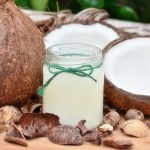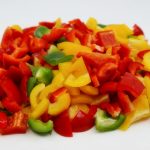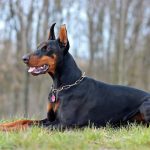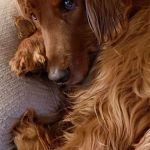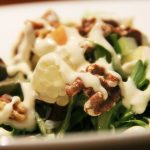The Goldendoodle is a cross between two well-loved breeds, the Golden Retriever and the Standard Poodle. It’s the top pick for people who want the traits of the Golden Retriever but prefer a hypoallergenic pet similar to the Poodle.
If you have been longing to have a pet but worried about your allergies, a “hypoallergenic” Goldendoodle may be the answer to your prayers. Read on to know the truth behind this term and whether this crossbreed is really a good choice for allergy sufferers.
What Makes a Dog Hypoallergenic?
Truth is, there is no such thing as a hypoallergenic dog. This is a clarification from American Veterinary Medical Association’s spokeswoman Bernadine Cruz. It’s just that some breeds produce less dander compared to others and that’s what makes them ideal for people with allergies to pets.
Contrary to popular belief, it’s not pet hair that normally makes us sneeze, develop hives, or have a runny nose around dogs. It’s either the dander (dead hair from the dog’s skin) or saliva that causes allergic rhinitis in humans. The proteins they contain are the substances your body is reacting to.
Pet dander is a microscopic substance that remains in the air for a long time. It can easily spread through your home, especially on surfaces like beddings and fabrics. Because it lingers in places, it can still be on the surfaces of your home even when you no longer have a pet.
While pet hair is not an allergen, it can collect dander and saliva that could cling everywhere in the house, like on clothing and furniture. Humans with over-sensitive immune systems may also have allergies to pet urine and may not even notice it, because the proteins in them are tiny and ubiquitous.
Signs of Allergy to Pets
If you have minor allergies to pet dander or saliva, the signs will not come out immediately. They will only show several days after being in contact with the dog. However, if you have an extremely sensitive immune system, you may exhibit signs as soon as 15 minutes since exposure to the allergen. Keep an eye for the following symptoms:
- Runny nose
- Pain due to congested nose
- Watery eyes
- Skin rashes
- Sneezing
Consider immunotherapy or shots to treat any allergic conditions you have when around pets. Allergy shots are not just effective against allergens from dogs like pet dander, urine, or saliva but they can also be your defense against other potential causes of hypersensitivity like house dust, insect bites, and mold.
People with asthma can also benefit from allergy shots because they can ease the reactions that could prompt asthma episodes. You may ask your doctor about allergy shots and their other benefits for asthmatic people.
In the case of Goldendoodles, it is worth noting that its parents have different coat characteristics. Poodles have a non-shedding coat and produce less dander. On the contrary, the Golden Retrievers shed profusely especially when they blow their coats.
What is the chance of the Goldendoodle to be a non-shedding dog like the Poodle? You’ll learn about it in the succeeding paragraphs.
Goldendoodle Coat 101
The goal of breeding Poodles with other purebred dogs is to produce a non-shedding crossbreed. However, there is no 100% assurance that the offspring will inherit the coat of a Poodle.
Goldendoodles actually have four types of coat textures and here is what these coats look like:
- Curly – a Goldendoodle with a curly coat is a product of two dogs both possessing the curl gene. If you want a Goldendoodle that looks a lot like the Poodle, you may ask your breeder about a dog’s coat possibilities. A KRT71 gene testing determines if a Goldendoodle will likely become curly.
- Straight – this coat is a result of having two parents without a curl gene. Goldendoodles with a straight coat are the ones with “furnishings” or long hair around the face. These are the types that tend to shed more than the others.
- Wavy – it is the result of one parent having the curl gene and one having a non-curl gene. Like the straight-haired Goldendoodles, the wavy ones may also have facial hair. The retriever’s straight coat is well-combined with a Poodle’s curls.
- Improper flat – a Goldendoodle with an “improper flat” coat does not have furnishings. These dogs have a very close resemblance to the face of the Golden Retriever.
F1 Goldendoodles
An F1 Goldendoodle, which is 50% Poodle and 50% Golden Retriever is more prone to shedding but if you want a pet that has a good balance of both breeds, this is the ideal type of Goldendoodle to have as a pet. They have looser curls and a more shaggy coat compared to the F1B Goldendoodles.
Does a Goldendoodle go through a seasonal shedding? Yes, F1 Goldendoodles are especially prone to shedding but it is usually light. Better be prepared during the spring and the fall because these are the times when the F1 Goldendoodle could blow its coat.
Believe it or not, this generation is actually the most popular of them all. Many people have a preference for Goldendoodles with long and wavy hair. If you love the Golden Retriever breed, you will likely get an F1 doodle as well. As adult dogs, F1 doodles have wavy medium-length hair.
More than the coat characteristics, it could inherit a lot of the Golden Retriever’s best traits, like their will-to-please attitude and being extremely friendly even with kids and other pets.
F1B Goldendoodles
A Goldendoodle that does not shed likely came from the F1B generation. They don’t produce a lot of dander, which makes them a great choice for people with allergies. This is due to the fact that their gene is 75% Poodle and 25% Golden Retriever.
Goldendoodles coming from this generation usually sport a teddy bear-like appearance. They have more curly hair than straight hair, which only means they are less prone to shedding. They are not just fluffy and cute, they are also the most recommended generation for families with hypersensitivity to pets.
Since they get plenty of their traits from the Poodle, they will likely become trainable dogs that enjoy socialization and lots of time outdoors. There is a tendency for them to be quite alert when around strangers, just like the Poodles.
F2 Goldendoodles
An F2 Goldendoodle is the offspring of two F1 Goldendoodles. Like their parents, they are 50-50 Poodle and Golden Retriever. Because they have enough of the Golden Retriever gene in their lineage, they have the tendency to shed more than the F1B doodles.
They are not easy to find and it will a little bit tricky to know their traits which can be random, so there is no guarantee if they will have more of the best characteristics of the Poodle or the Golden Retriever.
F2B Goldendoodles
If you want a little more of the Retriever but still prefer a dog that sheds moderately, the best option you have is the F2B Goldendoodle. It’s a combination of two F1B Goldendoodles, making it 62.5% Poodle and 37.5% Golden Retriever.
With a dominant Poodle gene, the majority of the F2B dogs have a curly coat. Still, there are puppies in the litter with wavy or straight fur. The best thing about them is they have a low chance of shedding, given that they have more of the Poodle’s non-shedding characteristics.
Multi-generation Goldendoodles
Apart from the F1B, F1, and F2B Goldendoodles, there is also the so-called multi-generation doodle. They are the F3 Goldendoodles, a combination of two F1B Goldendoodles. They also result in 75% Poodle and 25% Golden Retriever.
While they have more of the Poodle gene like the F1B Goldendoodles, many of these pups are actually more prone to shedding. Some puppies in the litter could have straighter coats, while some can have more curly hair. If you are sensitive to pet dander and going to choose from this generation, go for the ones with a curly coat.
Important Reminders before Getting a Goldendoodle
Many breeders these days offer the T-Shirt Allergy Test to help you determine if you can tolerate a puppy from a specific generation. This test is a must-do for people with moderate to severe allergies eager to get a Goldendoodle.
Nonetheless, it’s important to remember that you cannot tell if a Goldendoodle will shed or not until it transitions into adulthood. The appearance of the adult coat occurs right from a year old or until the dog is 18 months of age.
The best way to cope with tufts of hair is to brush your pet more often than usual. This helps get rid of dead hair that can attract dander. To learn more how to deal with your allergy to pets, read our tips below.
Tips to Prevent Pet Allergies
Do you have a history of hypersensitivities to pets in the past? If it’s extreme, we suggest avoiding any contact with dogs. It’s a better option than risking your health. But if this is manageable and you want to keep your Goldendoodle, you will be glad that there are things you can do to make it work and here are some tips from us:
- Consider HEPA air cleaners. Standing for High Efficiency Particulate Air, these types of filter work by trapping harmful particles like pet dander, dust mites, pollen, and tobacco smoke. Households with pets are recommended to change air filters every month. The best air purifiers for pets are those with multiple stage filtrations to completely get rid of dander.
- Keep a lint remover brush in handy. If you happen to have a Goldendoodle that sheds, this will be a nice tool to have for easy removal of pet hair in surfaces like beddings and couches. Get a lint roller with replacement sheets so you will not have to keep buying a new one.
- Use a rubber glove to remove the pet hair from furniture. There are so many hair removal tools out there but the good old rubber gloves are still one of the best. See how much the fur ball you will grow by rubbing in one direction.
- Vacuum frequently. Experts recommend vacuuming at least once every two days to avoid hair from accumulating at home. For carpeted floors, it is recommended to steam clean them every week. A standard vacuum will be fine, but if you have lots of pets at home a vacuum with special features like the Anti-Hair Trap Technology and Dog Canister will be worth the investment.
- Minimize furnishings that easily catch dander. A carpeted floor can catch more dander and dust than a hardwood floor. Likewise, a cloth curtain can also attract pet dander. Microfiber, silk, and polyester are the types of fabrics that repel pet hair. Heavily textured fabrics like velvet can easily catch pet hair and it will be difficult to remove.
- Don’t bathe your pet too often. It can lead to skin dryness that exacerbates shedding. Your Goldendoodle should only be given his bath once a month. Every three weeks will be fine if your Goldendoodle is an active one that often gets soiled.
- Use an all-natural shampoo for your dog. A lot of the pet shampoos on the market are made of chemicals that can be harsh on the dog’s skin, especially for Goldendoodles with sensitive skin. Choose products made of natural ingredients, like oatmeal and coconut.
Conclusion
Goldendoodles have a variety of coat textures. Some are curly, some have a straight coat, while some have a wavy coat. Given that, it’s safe to say that not all Goldendoodles are hypoallergenic. Also, the term hypoallergenic is not true anyway. Still, the Goldendoodle is a good choice if you have pet allergies because it does not produce lots of dander. When deciding to adopt or buy one, ask your breeder about the different Goldendoodle generations.







